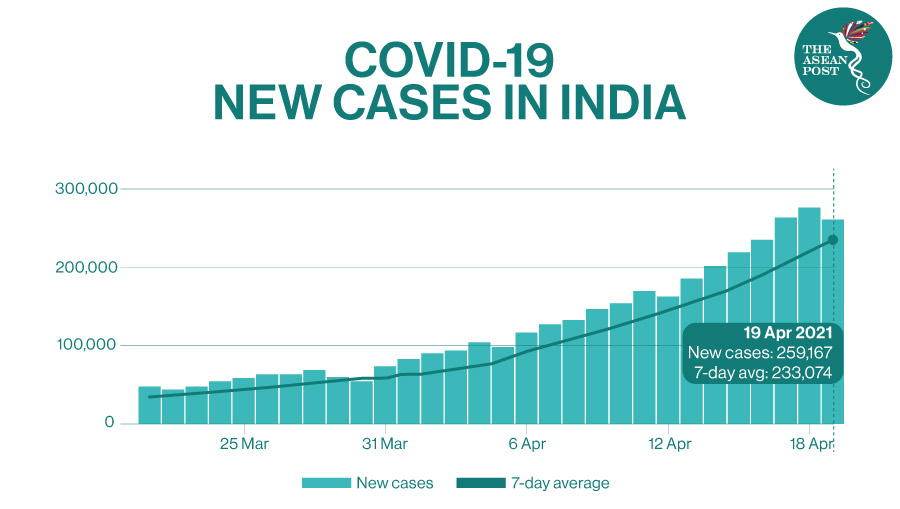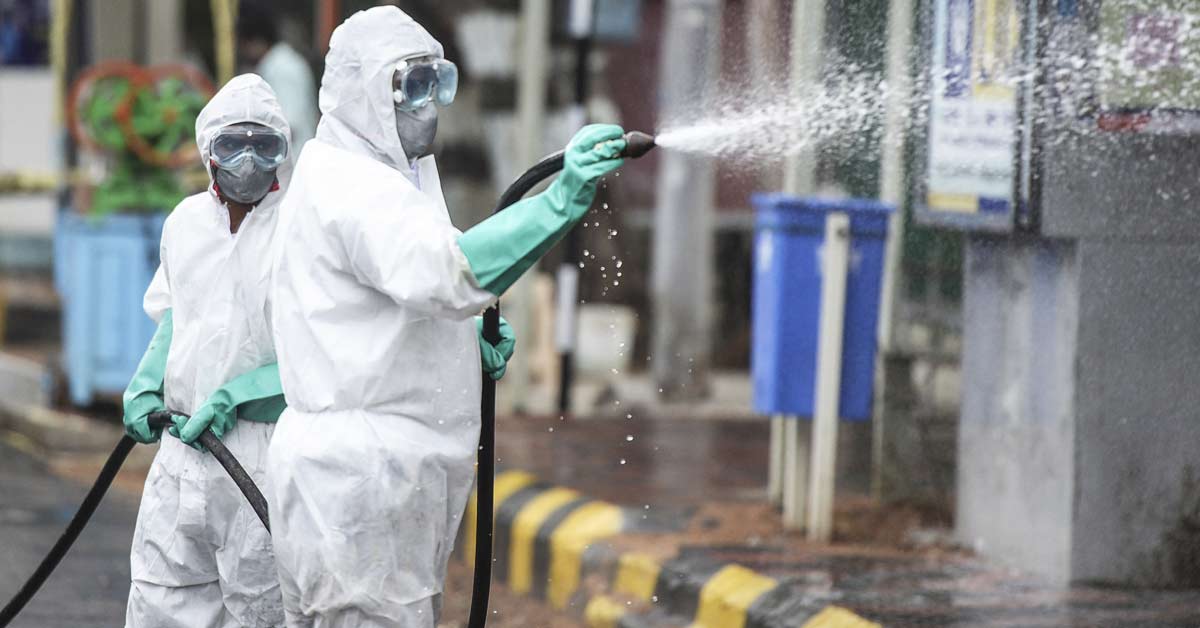With India’s daily tally of COVID-19 infections surging by records, public health experts worry that a new – possibly more virulent – coronavirus variant could be racing through the crowded nation of more than 1.3 billion people.
The new variant, which has a so-called double mutation, is thought to be fuelling India’s deadlier new wave of cases that has made it the world’s second worst-hit country, surpassing Brazil again, and has already begun to overwhelm its hospitals and crematoriums. India has reported more than 14.5 million COVID cases so far and more than 175,600 fatalities.
“This is a variant of interest we are following,” Maria Van Kerkhove, the World Health Organization’s (WHO) technical lead officer on COVID said. “Having two of these mutations, which have been seen in other variants around the world, are concerning,” she added, saying that there was a similarity with mutations that increase transmission as well as reduce neutralisation, possibly stunting the ability of vaccines to curb them.
The new strain underscores the insidious nature of viruses and threatens to thwart containment efforts in India, despite measures such as the world’s largest lockdown last year. An exploding outbreak in India risks undoing a hard-won victory over the pathogen for others, too, especially as this strain has now jumped to at least 10 other countries.
Here’s what we know so far:
How Did The “Double Mutation” Variant Emerge?
The new variant, called B.1.617, was initially detected in India with two mutations – the E484Q and L452R. It was first reported late last year by a scientist in India and more details were presented before the WHO, according to Van Kerkhove. Viruses mutate all the time, as part of evolutionary biology. Some mutations weaken the virus while others may make it stronger, enabling it to proliferate faster or cause more infections.
India’s health ministry first acknowledged the presence of a “double mutant” at the end of March, but has downplayed it since. While it’s a variant of interest, it “has not been stamped as a ‘variant of concern’ so as to say that it is more lethal or more infectious,” Aparna Mukherjee, a scientist at the Indian Council of Medical Research (ICMR), which works under the nation’s health ministry explained.
The double mutation has been found in several countries like Australia, Belgium, Germany, Ireland, Namibia, New Zealand, Singapore, the United Kingdom (UK) and the United States (US), according to a 16 April statement from the Indian government. “Higher transmissibility of this variant is not established as yet,” it said.
Is It Causing The Record Surge In India’s Infections?
Genome sequencing indicates the variant as a possible culprit, although the Indian government hasn’t confirmed it.
The average prevalence of the variant surged to as high as 52 percent of samples sequenced in April from almost nothing in January, according to website tracker outbreak.info, which uses data from GISAID, a global repository of genomic data of influenza viruses and the coronavirus responsible for the COVID-19 pandemic.
In some districts in Maharashtra state – home to Mumbai and the epicentre of the current wave that’s triggered fresh lockdown-like rules – the prevalence of this variant was more than 60 percent according to Anurag Agrawal, director of the state-run Council of Scientific and Industrial Research’s genomics institute that’s conducting sequencing.
The B.1.617 was present in samples from about 10 Indian states and while the percentage may vary, it was expected to rise as “it has two critical mutations that make it more likely to transmit and escape prior immunity,” Agrawal said.
Both mutations are known to decrease – although not completely eliminate – the binding of the antibodies created by infection and vaccination, according to Jesse Bloom, an associate professor for genome sciences and microbiology at the University of Washington.
“Mutations at sites E484 and L452 have been observed separately, but this is the first major viral lineage that combines the two,” said Bloom. “I do think that this new viral variant is important to monitor.”
“We did the math – we do believe that a lot of the increase in the reproduction number can be explained by these mutations,” said Nithya Balasubramanian, the head of health-care research at Bernstein India. “So, yes, the mutations are a big cause for worry.”
Non-compliance with physical distancing, mask-wearing and other public health measures may also have contributed to the current surge, according to Stephen Goldstein, a research associate in evolutionary virology at the University of Utah. “It’s difficult to say if any given variant is responsible without a fair amount of pretty rigorous epidemiological work,” he said, adding that scientists would need genome sequencing on a representative sample of viruses to pin down the percentage of Indian cases infected with this variant.
After being complacent in mapping virus genomes in recent months – India did sequencing for less than one percent positive samples as of last month – the country is now scrambling to cover lost ground. “We are attempting to do at least five percent of whatever samples are there,” said ICMR’s Mukherjee.
“It looks like that it is spreading faster than pre-existing variants,” said Rakesh Mishra, the Hyderabad-based director of the Centre for Cellular and Molecular Biology – another Indian lab doing genome sequencing of COVID samples. “Sooner or later, it will become prevalent in the whole country, given the way it is spreading.”
Has It Been Found Outside India?
This variant has been detected in at least 10 other countries, including the US, UK, Australia and New Zealand, according to the situation report on outbreak.info. As of 16 April, 408 sequences in the B.1.617 lineage have been detected of which 265 were found in India, the report shows. A surveillance report by the UK government said it has found 77 cases in England and Scotland so far, designating it as a “Variant Under Investigation.”

New Zealand has temporarily suspended arrivals of its citizens and residents from India due to the spike in the number returning with COVID. Hong Kong will ban flights from India, Pakistan and the Philippines for 14 days starting 20 April while Macau has extended quarantine for travellers from these three countries to 28 days. Brazil was also shunned as a COVID superspreader by its neighbours who were nervous about the virus strain next door. India’s second wave – given its size and rapid pace – will worry other nations that have just about managed their own outbreaks after weeks of economy-devastating lockdowns.
Is It Deadlier Than Other Variants?
Researchers are still trying to figure that out. The features of the double mutant variant are under investigation, but the L452R mutation is well characterised in US studies, according to Agrawal. It increases viral transmission by around 20 percent and reduces antibody efficacy by more than 50 percent, he said.
Globally, three worrisome variants that have so far emerged in the UK, South Africa and Brazil have caused particular concern. Studies suggest they are more contagious, and some evidence points to one of them being more deadly while another drives re-infection.
This double mutant strain, first found in India, has begun troubling virologists everywhere.
“The B.1.617 variant has all the hallmarks of a very dangerous virus,” William A Haseltine, a former professor at Harvard Medical School wrote in Forbes on 12 April: “We must do all that is possible to identify its spread and to contain it.”
Do Vaccines Work Against It?
It’s hard to know for sure without adequate data and research. India is testing whether the new variants, including the B.1.617, are capable of “immune escape or not,” according to ICMR’s Mukherjee. Immune escape refers to a pathogen’s ability to evade human bodies’ immunity response. This means antibodies created after vaccination or prior infection may not protect a person from getting infected.
If the new India variant shows “immune escape” behaviour, this would have deep ramifications for India’s vaccination program, which has picked up after a sluggish start and administered almost 120 million doses so far.
India has currently authorised three vaccines.
Two of them are already in use while the third, Russia’s Sputnik V, was approved this week. India also fast-tracked approval for foreign vaccines this week. All of these efforts risk being jeopardised if the shots turn out to be less effective against this double mutation variant.
“It is one of the ones that’s on our radar, and in doing so, it means it’s on the radar of people around the world,” said Van Kerkhove. – Bloomberg
Related Articles:
